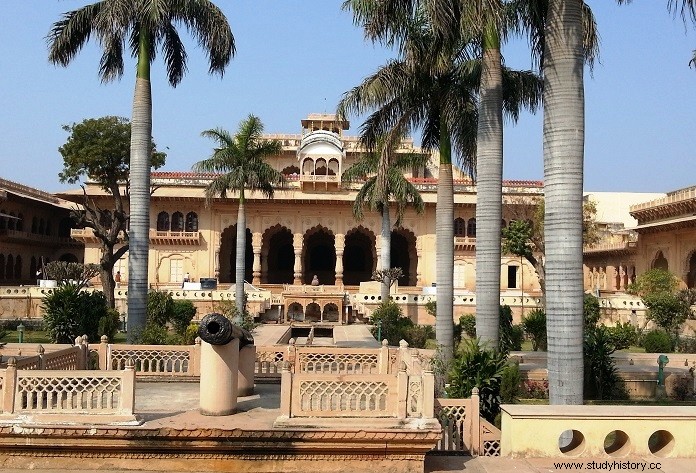
During the period of Akbar and Shah Jahan, many grand buildings were constructed in many cities like Agra, Fatehpur Sikri and Delhi. These buildings became symbols of the glory of the Mughals. After getting the title of Raja in AD 1722, Raja Badan Singh and his son Surajmal decided to build magnificent buildings in Deeg so that their kingdom also looked as magnificent as the kingdoms of Mughals and Rajputs.
During that period, a large number of craftsmen and their assistants used to wander about for employment because they stopped getting construction work after Aurangzeb became the emperor. The families of the master craftsmen who had built great constructions like Red Fort, Taj Mahal and Buland Darwaza were starving at this time. Therefore, flocks of craftsmen came from far and wide to the court of Badan Singh and Surajmal and started asking for work. The craftsmen were given the task of constructing buildings according to their wishes. Raja Badan Singh and Prince Surajmal opened the mouths of their treasury to give employment to the craftsmen.
The fort, buildings and gardens of Deeg were built around AD 1725. A red stone house was built for Raja Badan Singh, which is presently with the medical department. The poetic description of Deeg's fort, gardens, lakes, palaces, ponds and temples is found in Sujan-vilas composed by Somnath, the Rajkavi of Surajmal. It was a difficult task to transport marble from Bansi Paharpur and red stone from Baretha to Bharatpur, Kumher and Vair. For this 1000 bullock carts, 200 horse carts, 1500 camel carts and 500 mules were employed.
About 20 thousand men and women worked night and day for almost a quarter century in getting the huge buildings constructed at these four places and many temples in Vrindavan, Govardhan and Ballabhgarh. In Vrindavan, two great queens of Maharaja Surajmal - Ganga and Mohini built a beautiful building. Fifteen miles east of Deeg, Badan Singh built a beautiful building in Sahar, which later became his residence.
Due to these constructions, Deeg became a beautiful garden city whose splendor competed with that of Agra, Delhi and Jaipur. The forest of Soghar, situated twenty miles south-west of Deeg, was cut and swamped, and the huge and grand Bharatpur fort was built there. The main building of Deeg, Gopal Bhavan was completed by AD 1745. The entire building is made of red stone. There is a very beautiful marble swing in front of Gopal Bhavan, it was brought by Surajmal from Delhi in bullock carts. The date 1630-31 is inscribed on its post.
In AD 1732, Surajmal started building a fort named Lohagarh in the southern part of Bharatpur city. The construction of this fort was completed in eight years. These also included two trenches. The first moat was near the outer wall of the city and the second, less wide but deeper, surrounded the fort. Lord Lake laid a four-month long siege on this fort in AD 1805, but the lake could not succeed even after losing more than 3000 British soldiers and he had to make a treaty with the then Maharaja Ranjit Singh of Bharatpur. Between Deeg and Bharatpur relatively small forts were built at Kumher and Vair. Surajmal's younger brother Pratap Singh lived in Vaire. King Surajmal built grand palaces for his queen Hansia in Kumher, situated between Bharatpur and Deeg.
